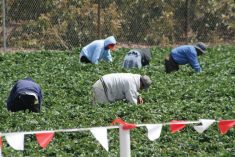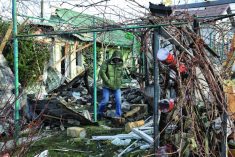CP Rail has hit back at criticism that trains are a major cause of wildfires, but rail traffic will continue to be affected — at least in the short term — by the tragic events at Lytton, B.C.
Two weeks after a June 30 wildfire destroyed 90 per cent of the small community and took the lives of two residents, the federal transport minister issued an order designed to lower the risk of trains causing wildfires in B.C.’s southern Interior.
Read Also

Grazing ‘sweet spot’ boosts pasture performance
Timing-focused approach to pasture management touted to boost forage growth, livestock gains while also cutting farmer labour and inputs
When the fire danger is “extreme” — that is, over 30 C — CN and CP rail must take a number of measures, including reducing speeds and having the capacity to respond to any fire detected along their rights-of-way within 60 minutes. And they can’t use a locomotive unless it has been inspected in the previous 15 days. The order is in effect until Oct. 31.
But it was comments by the chair of the Transportation Safety Board that led to a war of words.
An interim report by the safety board was unable to identify the cause of the Lytton fire, although some residents said it appeared it may have started along the train tracks and moved into town. The board chair said a full report on the incident could take two years but nevertheless said the fire “is certainly a wake-up call to really look at what precautions need to be taken by railway companies.”
Kathy Fox said there were 100 reported fires sparked by rail operations in 2019 and 76 in 2020.
“At the end of the day, you’ve got to look at how do you prevent a fire from starting on a train or how do you prevent a train from throwing off combustible materials that then ignite a fire, to what can you do to mitigate through observation,’’ Fox told the Canadian Press news agency.
That prompted CP Rail, which operated the last train to go through Lytton before the fire, to take the rare step of rebuking comments from a Transportation Safety Board official.
The railway said Transport Canada inspected the train and found no problems, and that CP also inspected that train and others that passed through the town prior to the fire and “found nothing to indicate that any of CP’s trains or equipment that passed through Lytton caused or contributed to the fire.”
“A review of the key facts confirms that railways are not a significant cause of wildfires in B.C., contrary to media and government speculation,” CP said. “The vast majority of wildfires are caused by nature when environmental conditions are extremely hot and dry, like those recently experienced in B.C.”
‘Weak link’
The rugged geography of B.C.’s interior makes for challenging conditions for rail movement. CP and CN share lines with trains heading west using one set of tracks and eastbound traffic on the other. The last train that passed through Lytton prior to the fire was CP locomotives and railcars running on the CN line.
When the fire damaged CN’s bridge by the town, some CN trains moved east on CP’s line, creating a backlog for both railways. The bridge reopened for traffic on July 13. (As well, rail traffic was also halted for 48 hours on July 9-11 on the orders of Transport Canada.)
Meanwhile, CN is following safety protocols to prevent fires, said spokesman Mathieu Gaudreault.
“Moreover, we are increasing patrols that precede and follow trains,” Gaudreault wrote in an email. “These patrols are equipped with fire suppression equipment and keep a constant lookout for any signs of fire risk.”
The Western Grain Elevator Association, which represents Canada’s major grain companies, is monitoring the impact on grain movement.
“If there is such a thing as a silver lining in this case it is we are in a slower (grain) shipping period relatively speaking,” said executive director Wade Sobkowich. “It would be much more impactful if this was to happen in October for example. That being said, for the grain still needing to move, the impact of the Lytton fires is that exporters are not able to load and execute in a timely fashion.
“The perception might be there’s not a lot of grain left… so it’s not having as big an impact, but… it is impacting that grain that wants to move and is destined for vessels to execute on a sale to a customer.”
As for how the transport minister’s order affects grain movement, Sobkowich said it depends on the weather.
“It depends on how many days we have over 30 C,” he said. “And it depends on other traffic. It depends on so many variables. That order puts operational restrictions on those lines when the (fire) hazard rating is listed as extreme. So when will that be between now and the end of October?”
Western Canadian grain shipments to Vancouver had been running at a record pace for much of the crop year, but were slowing in recent weeks as is usually the case just ahead of harvest.
But the Lytton fire and other wildfires underscore how reliant grain farmers are on just two rail lines running through B.C., Sobkowich said.
“It’s a narrow track… and if any piece of it is disrupted it affects the whole thing,” he said. “It really defines the saying, ‘We are only as strong as our weakest link.’”















